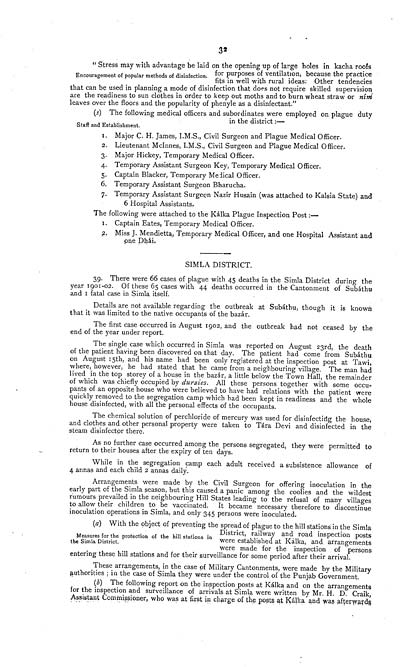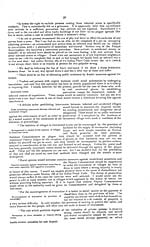Medicine - Disease > Report on plague in the Punjab from October 1st ... to September 30th ..., being the ... season of plague in the province
(46) Page 32
Download files
Individual page:
Thumbnail gallery: Grid view | List view

32
Encouragement of popular methods of disinfection.
" Stress may with advantage be laid on the opening up of large holes in kacha roofs
for purposes of ventilation, because the practice
fits in well with rural ideas: Other tendencies
that can be used in planning a mode of disinfection that does not require skilled supervision,
are the readiness to sun clothes in order to keep out moths and to burn wheat straw or nm
leaves over the floors and the popularity of phenyle as a disinfectant."
(s) The following medical officers and subordinates were employed on plague duty
in the district :-
Staff and Establishment.
Encouragement of popular methods of disinfection.
1. Major C. H. James, I.M.S., Civil Surgeon and Plague Medical Officer.
2. Lieutenant McInnes, I.M.S., Civil Surgeon and Plague Medical Officer.
3. Major Hickey, Temporary Medical Officer.
4. Temporary Assistant Surgeon Key, Temporary Medical Officer.
5. Captain Blacker, Temporary Medical Officer.
6. Temporary Assistant Surgeon Bharucha.
7. Temporary Assistant Surgeon Nazr Husain (was attached to Kalsia State) and
6 Hospital Assistants.
The following were attached to the Klka Plague Inspection Post :--
1. Captain Eates, Temporary Medical Officer.
2. Miss J. Mendietta, Temporary Medical Officer, and one Hospital Assistant and
one Dhi.
SIMLA DISTRICT.
39. There were 66 cases of plague with 45 deaths in the Simla District during the
year 1901-02. Of these 65 cases with 44 deaths occurred in the Cantonment of Subthu
and I fatal case in Simla itself.
Details are not available regarding the outbreak at Subthu, though it is known
that it was limited to the native occupants of the bazr.
The first case occurred in August 1902, and the outbreak had not ceased by the
end of the year under report.
The single case which occurred in Simla was reported on August 23rd, the death
of the patient having been discovered on that day. The patient had come from Subthu
on August 15th, and his name had been only registered at the inspection post at Tawi,
where, however, he had stated that he came from a neighbouring village. The man had
lived in the top storey of a house in the bazr, a little below the Town Hall, the remainder
of which was chiefly occupied by durzies. All these persons together with some occu-
pants of an opposite house who were believed to have had relations with the patient were
quickly removed to the segregation camp which had been kept in readiness and the whole
house disinfected, with all the personal effects of the occupants.
The chemical solution of perchloride of mercury was used for disinfecting the house,
and clothes and other personal property were taken to Tara Devi and disinfected in the
steam disinfector there.
As no further case occurred among the persons segregated, they were permitted to
return to their houses after the expiry of ten days.
While in the segregation camp each adult received a subsistence allowance of
4 annas and each child 2 annas daily.
Arrangements were made by the Civil Surgeon for offering inoculation in the
early part of the Simla season, but this caused a panic " among the coolies and the wildest
rumours prevailed in the neighbouring Hill States leading to the refusal of many villages
to allow their children to be vaccinated. It became necessary therefore to discontinue
inoculation operations in Simla, and only 345 persons were inoculated.
Measures for the protection of the hill stations in
the Simla District.
(a) With the object of preventing the spread of plague to the hill stations in the Simla
District, railway and road inspection posts
Measures for the protection of the hill stations in were established at Klka, and arrangements
the Simla District. were made for the inspection of persons
entering these hill stations and for their surveillance for some period after their arrival.
These arrangements, in the case of Military Cantonments, were made by the Military
authorities ; in the case of Simla they were under the control of the Punjab Government.
(b) The following report on the inspection posts at Klka and on the arrangements
for the inspection and surveillance of arrivals at Simla were written by Mr. H. D. Craik,
Assistant Commissioner, who was at first in charge of the posts at Klka and was afterwards
Encouragement of popular methods of disinfection.
" Stress may with advantage be laid on the opening up of large holes in kacha roofs
for purposes of ventilation, because the practice
fits in well with rural ideas: Other tendencies
that can be used in planning a mode of disinfection that does not require skilled supervision,
are the readiness to sun clothes in order to keep out moths and to burn wheat straw or nm
leaves over the floors and the popularity of phenyle as a disinfectant."
(s) The following medical officers and subordinates were employed on plague duty
in the district :-
Staff and Establishment.
Encouragement of popular methods of disinfection.
1. Major C. H. James, I.M.S., Civil Surgeon and Plague Medical Officer.
2. Lieutenant McInnes, I.M.S., Civil Surgeon and Plague Medical Officer.
3. Major Hickey, Temporary Medical Officer.
4. Temporary Assistant Surgeon Key, Temporary Medical Officer.
5. Captain Blacker, Temporary Medical Officer.
6. Temporary Assistant Surgeon Bharucha.
7. Temporary Assistant Surgeon Nazr Husain (was attached to Kalsia State) and
6 Hospital Assistants.
The following were attached to the Klka Plague Inspection Post :--
1. Captain Eates, Temporary Medical Officer.
2. Miss J. Mendietta, Temporary Medical Officer, and one Hospital Assistant and
one Dhi.
SIMLA DISTRICT.
39. There were 66 cases of plague with 45 deaths in the Simla District during the
year 1901-02. Of these 65 cases with 44 deaths occurred in the Cantonment of Subthu
and I fatal case in Simla itself.
Details are not available regarding the outbreak at Subthu, though it is known
that it was limited to the native occupants of the bazr.
The first case occurred in August 1902, and the outbreak had not ceased by the
end of the year under report.
The single case which occurred in Simla was reported on August 23rd, the death
of the patient having been discovered on that day. The patient had come from Subthu
on August 15th, and his name had been only registered at the inspection post at Tawi,
where, however, he had stated that he came from a neighbouring village. The man had
lived in the top storey of a house in the bazr, a little below the Town Hall, the remainder
of which was chiefly occupied by durzies. All these persons together with some occu-
pants of an opposite house who were believed to have had relations with the patient were
quickly removed to the segregation camp which had been kept in readiness and the whole
house disinfected, with all the personal effects of the occupants.
The chemical solution of perchloride of mercury was used for disinfecting the house,
and clothes and other personal property were taken to Tara Devi and disinfected in the
steam disinfector there.
As no further case occurred among the persons segregated, they were permitted to
return to their houses after the expiry of ten days.
While in the segregation camp each adult received a subsistence allowance of
4 annas and each child 2 annas daily.
Arrangements were made by the Civil Surgeon for offering inoculation in the
early part of the Simla season, but this caused a panic " among the coolies and the wildest
rumours prevailed in the neighbouring Hill States leading to the refusal of many villages
to allow their children to be vaccinated. It became necessary therefore to discontinue
inoculation operations in Simla, and only 345 persons were inoculated.
Measures for the protection of the hill stations in
the Simla District.
(a) With the object of preventing the spread of plague to the hill stations in the Simla
District, railway and road inspection posts
Measures for the protection of the hill stations in were established at Klka, and arrangements
the Simla District. were made for the inspection of persons
entering these hill stations and for their surveillance for some period after their arrival.
These arrangements, in the case of Military Cantonments, were made by the Military
authorities ; in the case of Simla they were under the control of the Punjab Government.
(b) The following report on the inspection posts at Klka and on the arrangements
for the inspection and surveillance of arrivals at Simla were written by Mr. H. D. Craik,
Assistant Commissioner, who was at first in charge of the posts at Klka and was afterwards
Set display mode to: Large image | Zoom image | Transcription
Images and transcriptions on this page, including medium image downloads, may be used under the Creative Commons Attribution 4.0 International Licence unless otherwise stated. ![]()
| India Papers > Medicine - Disease > Report on plague in the Punjab from October 1st ... to September 30th ..., being the ... season of plague in the province > (46) Page 32 |
|---|
| Permanent URL | https://digital.nls.uk/74579396 |
|---|




